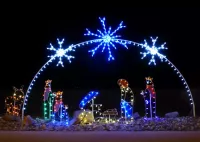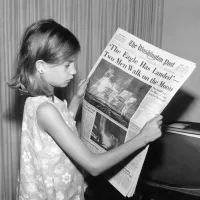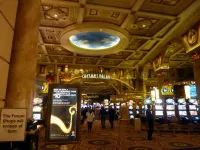Public opinion and media debates around Damien Hirst—discover key moments of controversy.
Damien Hirst is a prominent English artist and art collector, known as one of the Young British Artists (YBAs) who significantly impacted the UK art world in the 1990s. Reputedly the wealthiest living artist in the UK, Hirst's career was initially intertwined with collector Charles Saatchi. Their collaborative relationship eventually dissolved due to growing tensions in 2003. Hirst's work is often characterized by controversial themes and materials, solidifying his place as a major figure in contemporary art.
1994: Serpentine Gallery Exhibition and Vandalism
In 1994, Damien Hirst curated the show Some Went Mad, Some Ran Away at the Serpentine Gallery, where he exhibited Away from the Flock. Mark Bridger vandalized the artwork by pouring black ink into the tank, leading to a court case.
1997: Book reference to vandalism leads to copyright suit
In 1997, When a photograph of Away from the Flock was reproduced in the book by Hirst I want to spend the rest of my life everywhere, with everyone, one-to-one, always, forever, now, the vandalism was referenced by allowing the tank to be obscured by pulling a card, reproducing the effect of ink being poured into the tank; this resulted in Hirst being sued by Bridger for violating his copyright on Black Sheep.
1997: Questions raised about authenticity of Hirst's work
In 1997, questions about authenticity arose when a spin painting that Damien Hirst said was a "forgery" appeared at sale, even though he had previously stated that he often had nothing to do with the creation of these pieces.
1999: Venice Biennale Rejection and British Airways Lawsuit Threat
In 1999, Damien Hirst turned down an invitation to be the UK's representative at the Venice Biennale. He also threatened to sue British Airways for copyright infringement over an advert design for its low-budget airline, Go.
1999: Foundation of Stuckist Art Group
In 1999, the Stuckist art group was founded with a specific anti-Britart agenda by Charles Thomson and Billy Childish. Damien Hirst is one of their main targets.
1999: Plagiarism Challenges Begin
Starting in 1999, Damien Hirst's works have been challenged and contested as plagiarized 16 times. One instance involved his sculpture Hymn, which led to legal proceedings and an out-of-court settlement.
2000: Hirst Sued for Copyright Breach Over "Hymn" Sculpture
In 2000, Damien Hirst was sued for breach of copyright over his sculpture, Hymn, which was an enlargement of Connor's 14" Young Scientist Anatomy Set, designed by Norman Emms. Hirst settled out of court, donating an undisclosed sum to charities and making a "goodwill payment" to Emms, also agreeing to restrictions on further reproductions of the sculpture.
2003: Stuckism International Gallery Exhibition
In 2003, the Stuckism International Gallery exhibited a shark which had first been put on public display two years before Hirst's by Eddie Saunders. The Stuckists questioned why Hirst's shark was recognised as great art while Saunders' was not, suggesting that Hirst may have gotten the idea from Saunders' shop display.
2006: Robert Dixon alleges similarities between Hirst's print and his own design
In 2006, graphic artist Robert Dixon alleged that Damien Hirst's print Valium had "unmistakable similarities" to one of his own designs. Hirst's manager stated the origin of Hirst's piece was from a book The Penguin Dictionary of Curious and Interesting Geometry (1991), where Dixon's design was published.
2007: John LeKay claims to have inspired Hirst's works
In 2007, artist John LeKay claimed to have provided ideas and inspirations for a variety of Damien Hirst's later works, including the concept for Mother and Child, Divided, and For the Love of God. Copyright lawyer Paul Tackaberry reviewed images of LeKay's and Hirst's work and saw no basis for copyright infringement.
December 2008: Copyright Dispute over Skull Images
In December 2008, Damien Hirst, through the Design and Artists Copyright Society (DACS), demanded action against a 16-year-old graffiti artist, Cartrain, for works containing images of Hirst's skull sculpture 'For the Love of God'. Cartrain was selling these artworks on the internet gallery 100artworks.com.
2008: Robert Hughes' Criticism in The Mona Lisa Curse
In 2008, in the Channel 4 documentary 'The Mona Lisa Curse', art critic Robert Hughes criticized Damien Hirst's work as "tacky" and "absurd", questioning the value placed on his art and accusing him of functioning like a commercial brand.
June 2009: Copyright Law Analysis of Skull Images
In June 2009, copyright lawyer Paul Tackaberry compared images of Damien Hirst's skull with those created by graffiti artist Cartrain. Tackaberry stated that if a 'substantial portion' of the original appears in the new work, then that is all that is needed for copyright infringement.
2009: Negative Reception of No Love Lost Exhibition
Damien Hirst's 2009 show, 'No Love Lost', of paintings by his own hand, at the Wallace Collection in London, received "one of the most unanimously negative responses to any exhibition in living memory", with critics calling the work derivative and weak.
2010: Charles Thomson accuses Hirst of plagiarism in 3:AM Magazine and The Jackdaw
In 2010, Charles Thomson argued in 3:AM Magazine and The Jackdaw that there are 15 cases where Damien Hirst plagiarized the work of others. A spokesperson for Hirst called the article "poor journalism" and stated that Hirst would make a "comprehensive" rebuttal.
2012: Criticism of Two Weeks One Summer Exhibition
A 2012 exhibition of paintings by Damien Hirst at the White Cube gallery in Bermondsey, entitled "Two Weeks One Summer", provoked criticism in The Guardian.
2012: Complaints About Tate Gallery Retrospective
Damien Hirst's 2012 retrospective at the Tate Gallery received many complaints from the public, accusing the gallery of wasting taxpayers' money by showcasing art that was 'repetitive', 'meaningless', and 'almost universally awful'.
April 2016: Formaldehyde Leakage Study
In April 2016, a study published in Analytical Methods claimed Damien Hirst's preserved carcasses leaked formaldehyde gas above legal limits at Tate Modern. However, this study was later shown to be flawed.
May 2017: Accusations of appropriating Yoruba art in Golden Heads (Female)
In May 2017, Damien Hirst was accused of copying and appropriating Yoruba art from Ilé-Ifẹ̀ in his work Golden Heads (Female), which was on display in his exhibition Treasures from the Wreck of the Unbelievable at the Venice Biennale. Critics argued the work lacked appropriate context.
2022: Joe Machine accuses Hirst of plagiarism
In 2022, artist and writer Joe Machine accused Damien Hirst of plagiarism of his cherry blossom paintings, marking the 16th accusation of plagiarism against Hirst.
March 2024: Report of Hirst's formaldehyde animal works being made in 2017 instead of the 1990s
In March 2024, The Guardian reported that four of Damien Hirst's formaldehyde animal works, which his company Science Ltd. dated to the 1990s, were actually made in 2017. The works included a dove, two sharks, and two calves preserved in formaldehyde. Science Ltd. responded that the dates represented when the works were conceived, not made.
May 2024: The Guardian reveals paintings from The Currency project were created later than claimed
In May 2024, The Guardian revealed that at least 1,000 dot paintings on A4 paper from 'The Currency' project, claimed to be made in 2016 and inscribed with that year, were actually created years later. Lawyers for Hirst and Science Ltd. acknowledged this but stated it was Hirst's "usual practice" to date works from a conceptual art project with the date of the project's conception.
Mentioned in this timeline
Qatar is a country located on the Qatar Peninsula in...

Christmas is an annual festival celebrated on December th commemorating...
The Guardian is a British daily newspaper founded in as...
BBC News a division of the British Broadcasting Corporation is...

The Red Hot Chili Peppers formed in are a highly...

News encompasses information about current events disseminated through various media...
Trending
1 month ago Yankees Re-Sign Ryan Yarbrough to One-Year Deal: Bolstering Left-Handed Pitching
5 months ago Senator concerned JetBlue and United partnership may negatively affect market competition.

9 months ago Ian McKellen Returns to Marvel Universe in 'Avengers: Doomsday' as Magneto.

9 months ago Mike Bailey Responds To Ricochet Critics, Discusses Ring Gear and AEW Theme.

23 days ago Best Sweepstakes Casino Bonuses for Thanksgiving Weekend: Chumba and No Deposit Deals

1 month ago Dubai Overtakes New York as Top Destination for the World's Wealthy Elite.
Popular

Candace Owens is an American conservative political commentator and author...

Tucker Carlson is an American conservative political commentator known for...

XXXTentacion born Jahseh Dwayne Ricardo Onfroy was a controversial yet...

Kashyap Pramod Patel is an American lawyer who became the...

Ilhan Omar is an American politician currently serving as the...

Bill Gates an American businessman and philanthropist revolutionized personal computing...
